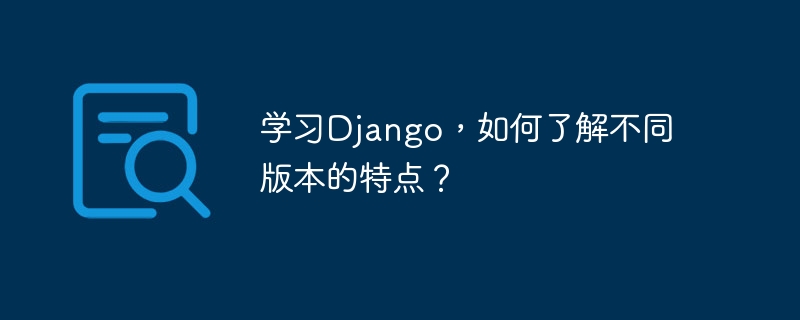Home >Backend Development >Python Tutorial >What are some ways to understand the characteristics of each version of Django?
What are some ways to understand the characteristics of each version of Django?
- WBOYOriginal
- 2024-01-03 17:50:481055browse

Learning Django, how to understand the characteristics of different versions?
Django is one of the widely used Python web frameworks, and the latest version is Django 3.1. However, as Django versions are updated, some features and APIs may change. As a Django developer, it is very important to understand the characteristics of different versions, which will help us better use and upgrade Django.
In this article, we will introduce in detail how to understand the features of different versions of Django and illustrate it through specific code examples. let's start!
- Django official documentation
To understand the characteristics of different versions of Django, the most important resource is the official documentation. Django's official documentation is very thorough and provides release notes and changelogs for each version. By reading these documents, we can learn about the new features, improvements, and backward-incompatible changes in each version. Let's take Django 2.0 and 3.0 as an example and compare some of their important features.
Important features of Django 2.0:
- Removed Python versions that are no longer supported, and only supports Python 3.4 and above.
- Added native support for Python async/await.
- Introduced a new routing system, using path() and re_path() to replace the url() function.
- Improved ORM, added new model fields and database support.
- Optimized performance, especially lazy loading of QuerySet.
Important features of Django 3.0:
- Removed Python versions that are no longer supported, and only supports Python 3.6 and above.
- Introduced ASGI (Asynchronous Server Gateway Interface) to support asynchronous processing of requests.
- Introduced improvements to the template engine, including support for async/await and automatic escaping.
- Updated ORM, added more aggregate functions and database support.
- Refactored the default behavior of deleting related fields (on_delete).
- Sample code
In addition to reading the official documentation, we can also have a deeper understanding of the features of different versions of Django by writing sample code. Below are two examples that demonstrate some of the new features in Django 2.0 and Django 3.0.
Example 1: The new routing system in Django 2.0
The following code shows how the newly introduced routing system in Django 2.0 works:
# myapp/urls.py
from django.urls import path
from . import views
urlpatterns = [
path('hello/', views.hello_world),
]
# myapp/views.py
from django.http import HttpResponse
def hello_world(request):
return HttpResponse("Hello, World!")In this example, We use the new path() function to define URL routes. This new routing system is more concise and intuitive, making it easier to use and maintain than the old url() function.
Example 2: ASGI support in Django 3.0
The following example shows how ASGI support in Django 3.0 works:
# myproject/asgi.py
import os
from django.core.asgi import get_asgi_application
os.environ.setdefault('DJANGO_SETTINGS_MODULE', 'myproject.settings')
application = get_asgi_application()In this example, we use the new get_asgi_application( ) function to get the ASGI application. This enables Django to handle asynchronous requests and interact with ASGI servers.
By writing and running these sample codes, we can better understand and experience the new features in Django 2.0 and Django 3.0.
Summary
Understanding the features of different versions of Django is the key to becoming an excellent Django developer. By reading official documentation and writing sample code, we can gain a deeper understanding of the new features and important improvements in each version. In this way, we can better take advantage of Django and be able to adapt to changes in a timely manner when upgrading to new versions.
I hope this article will be helpful for you to learn the features of the Django version! Start exploring!
The above is the detailed content of What are some ways to understand the characteristics of each version of Django?. For more information, please follow other related articles on the PHP Chinese website!

